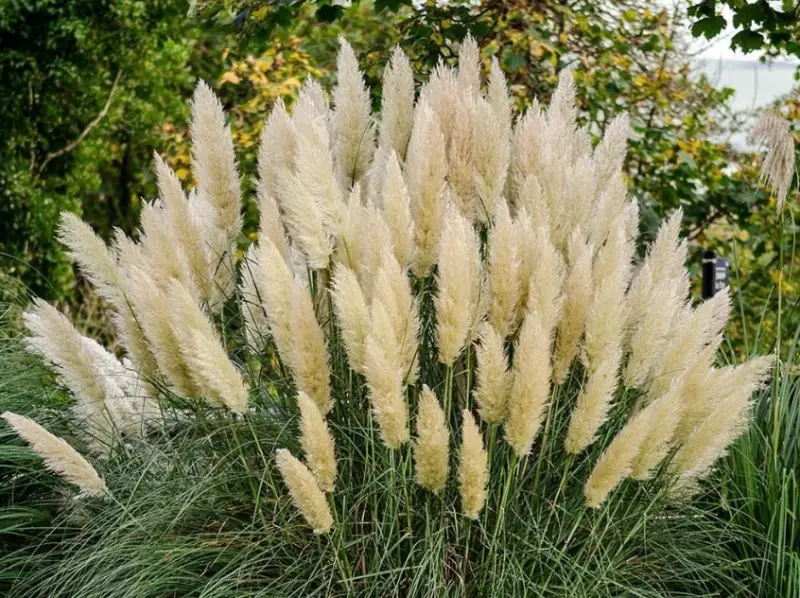Pampas grass, scientifically known as Cortaderia selloana, is a large, stunning ornamental grass that is easily recognizable due to its feathery white plumes. Native to South America, this plant thrives in hot and humid climates, but it can also survive in colder regions with the right conditions. If you’re looking to add this striking grass to your landscape, it’s important to know how to properly care for and maintain it.
In this guide, we’ll explore everything you need to know about pampas grass care, including its planting needs, pruning, propagation, and common issues.
What is Pampas Grass?

Pampas grass is a perennial grass that can grow up to 10 feet tall and wide, making it an impressive addition to any garden. This grass is valued for its large, showy plumes that come in shades of white, pink, or even silver. Despite its beauty, pampas grass is also highly resilient and can survive in a variety of climates, including colder regions, as long as it is planted in the right location. However, it is essential to be aware that pampas grass is considered invasive in certain parts of the world, including the United States, Australia, and New Zealand.
Basic Information:
- Common Name: Pampas grass
- Botanical Name: Cortaderia selloana
- Family: Poaceae
- Plant Type: Perennial
- Mature Size: 5-10 ft. tall, 5-10 ft. wide
- Sun Exposure: Full sun to partial shade
- Soil Type: Loamy, well-drained soil
- Soil pH: Acidic to neutral
- Bloom Time: Summer to fall
- Flower Color: White, pink, yellow
- Hardiness Zones: USDA 7-10
- Native Area: South America
How to Grow Pampas Grass
Light Requirements
For optimal growth, pampas grass prefers full sun but can tolerate partial shade. Planting the grass in an area with too much shade can lead to issues such as excessive moisture, which may cause fungal problems. To avoid this, ensure your pampas grass gets at least six hours of sunlight daily.
Soil and Watering
This plant thrives in loamy, well-drained soil that is rich in nutrients. The key to healthy pampas grass is good drainage, so adding compost or organic matter to the soil can help enhance its ability to drain water properly. Although pampas grass is drought-tolerant, newly planted specimens should be watered deeply until they establish a strong root system. Once established, the grass typically relies on natural rainfall for moisture, but during extended drought periods, supplemental watering may be necessary.
Temperature and Humidity
Pampas grass is highly adaptable and thrives in hot, humid climates. However, it can also withstand colder temperatures and even light frost. For regions with cold winters, pampas grass will go dormant during the winter and come back to life in the spring, making it a resilient choice for many climates.
Fertilizing Pampas Grass
While fertilizing is not essential for pampas grass, applying a balanced fertilizer in early spring after pruning can encourage lush new growth. It is important to follow the product label’s instructions on the amount and application method to avoid over-fertilizing, which can result in overgrowth without increasing plume production.
Types of Pampas Grass
There are several varieties of pampas grass that vary in size and plume color. Below are three popular types:
- Pumila: Known as dwarf pampas grass, this variety grows up to 5 feet tall and has pale yellow to ivory-colored plumes. It is a compact variety, making it ideal for smaller gardens or containers.
- Sunningdale Silver: This variety grows up to 10 feet tall and produces stunning silver plumes. It is less prone to clumping than other types, which makes it easier to manage.
- Rendatleri: Also called “pink feather,” this cultivar is famous for its beautiful pink plumes. It can grow up to 8 feet tall and adds a pop of color to any landscape.
Pruning Pampas Grass
Pruning pampas grass is essential for maintaining its appearance and promoting healthy growth. The best time to prune is in late winter or early spring, before new growth begins. Cut the grass all the way down to the ground using sharp garden shears or a pruning saw. Always wear protective gloves and clothing, as the blades of pampas grass are sharp and can cause cuts.
By pruning the grass each year, you prevent dead foliage from accumulating, which can lead to rot in the center of the plant. Regular pruning also helps encourage more vibrant plume production in the upcoming growing season.
Propagating Pampas Grass
Pampas grass can be propagated by division every few years. This process helps rejuvenate the plant and prevents overcrowding. Here’s how to propagate:
- In early spring, use a sharp shovel to dig up the plant and divide the root system into smaller sections.
- Separate the clumps and plant them in their own area, ensuring they are spaced at least 6 to 8 feet apart to allow room for growth.
- Water the newly planted divisions well and care for them as you would for any young plant.
Growing Pampas Grass from Seed
Although pampas grass can be grown from seed, this method may result in patchy growth and a higher chance of growing male plants, which produce fewer plumes. Here’s how to grow pampas grass from seed:
- Harvest seeds in late summer or early fall when the plumes are mature.
- Plant the seeds in well-draining soil, lightly covering them with a thin layer of soil.
- Keep the soil moist and place the pots in a location with bright, indirect light.
- Seeds should germinate in about three weeks.
- Once seedlings are large enough, transplant them into larger pots or directly into your garden after the last frost.
Potting and Repotting Pampas Grass
Despite its large size, pampas grass can be grown in containers, particularly dwarf varieties. Choose a large container with plenty of room for the plant to grow. Ensure the pot has good drainage to prevent waterlogging. When the plant outgrows its container, you can either divide the clump or transfer it to a larger pot.
To repot, simply turn the plant on its side and gently tap the pot to loosen the roots. Replant in a new container with fresh, well-drained soil, and water thoroughly.
Common Problems with Pampas Grass
Although pampas grass is generally low-maintenance, there are a few issues you should be aware of:
Fire Hazard
Pampas grass is highly flammable, especially when dry. Avoid planting it near buildings, outdoor cooking areas, or open flames. In some areas, it is considered a fire hazard, so always check your local regulations before planting.
Sharp Blades
The leaves of pampas grass are sharp and can cause injury if handled carelessly. Be sure to wear protective clothing when working with the plant, and avoid planting it in areas where children or pets play.
Invasiveness
Pampas grass spreads quickly by seed, and in some regions, it is considered invasive. To prevent the grass from taking over your garden or natural areas, consider planting sterile varieties that do not produce seeds.
Conclusion
Pampas grass is a striking and hardy addition to any garden, known for its tall stature and beautiful plumes. By providing full sun, well-draining soil, and annual pruning, you can enjoy its graceful beauty year after year. However, it’s crucial to be mindful of its invasive potential and fire hazard risks, especially in regions where it’s classified as a threat. With the proper care and attention, pampas grass can be a magnificent feature in your landscape, adding height, texture, and movement to your outdoor space.






